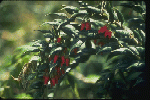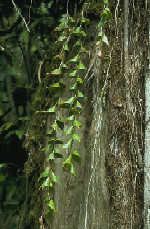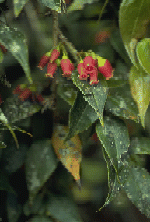- 20. Themistoclesia KLOTZSCH Linnaea 24: 41 (1851). --Lectotype: Themictoclesia
- pendula
KLOTZSCH.
Reference: SLEUMER, H. O., Uber die Gattung Themistoclesia
Kl. Notizbl. Bot. Gart. Mus. Berlin-Dahlem 13: 108--111 (1936).




Straggly to bushy, often epiphytic shrubs or shrublets. Leaves alternate, subcoriaceous
to coriaceous, occasionally thick-fleshy, obscurely plinerved or rarely pinnate,
short-petiolate. Inflorescence axillary, fasciculate, racemose, or flowers solitary; pedicel usually inconspicuously bibracteolate. Flowers (4-) 5-merous, without
odor; aestivation valvate; calyx continuous with the pedicel, although seemingly
articulate in T. alata
; hypanthium obconic or short-cylindric, strongly winged (T. alata
) or bluntly angled; limb erect to slightly spreading; lobes acute to acuminate,
minute to well developed; corolla ovoid to cylindric, terete or angled but not winged;
stamen 4--5 or 8--10, equal or alternately slightly unequal, more than 1/2 as long
as the corolla and often about as long as the corolla tube; filaments distinct, slender
and terete to somewhat flattened at the base, lacking spurs; anthers inserted medially
or almost basally, lacking disintegration tissue; thecae smooth; tubules nearly equal to or about two times longer than the thecae, generally 2 and separate, rarely
1 by fushion, dehiscing by short, introrse clefts; pollen lacking viscin threads;
nectariferous disc annular-pulvinate, glabrous or hispid; ovary inferior; style
filiform, about as long as the corolla. Fruit a berry; seeds numerous, small, the embryo
green and clearly visible through the surrounding tissue.
Themistoclesia
is a genus of about 25 species ranging from Costa Rica and Panama through the Andes
from Venezuela into Peru.
Key to Species of Themistoclesia
- 1a.
- Leaves obovate to oblong, cuneate at base; pedicel to 2.5 mm long, seemingly
articluate with the calyx; calyx strongly winged; corolla 3--4 mm long; staminal
tubules fused into one tubule
- .....................................................................................................T. alata
- 1b.
- Leaves ovate to elliptic, rounded, subcordate, or obtuse at base; pedicel (3--)
6--22 mm long, continuous with the calyx; calyx not winged but conspicuously angled;
corolla (6--) 7--11 mm long; staminal tubules 2, distinct.
- 2a.
- Leaves involute, funnel-shaped, amplexicaul, surrounding and totally concealing
the inflorescence
- ............................................................................................T. recondita
- 2b.
- Leaves flat, petiolate, not surrounding nor concealing inflorescence.
- 3a.
- Inflorescence with flowers solitary or few (2--3) in a fascicle; corolla 7 mm
long, glabrous; pubescence of pedicel and calyx soft, white puberulent or short-pilose;
nectariferous disc glabrous
- ...................................................................................T. inflata
- 3b.
- Inflorescence with flowers (1-) 2--15 in short (but conspicuous) to elongate racemes;
corolla 6--13 mm long, glabrous to hispid; pubescence of pedicel and calyx when
present hispid; nectariferous disc glabrous to hispid.
- 4a.
- Leaves apically short-acuminate or cuspidate, hispid beneath and also black-scurfy
due to a fungus; corolla 6--8 mm long, hispidulous all over or restricted in lines
along the length of the corolla opposite the lobes; rachis 5--10 mm long; pedicel 7--11 mm long
- ..........................................................................T. campii
- 4b.
- Leaves apically long-acuminate, mucronate, glabrous, glabrate, or hispid beneath;
corolla 9--13 mm long, glabrous or with pubescence restricted to the lobes; pedicel
6--20 mm long.
- 5a.
- Corolla cream-colored; nectariferous disc glabrous; inflorescence 1--2-flowered;
rachis 3--5 (-8) mm long; pedicel 8--10 mm long; corolla 9--13 mm long; pubescence
of inflorescence and stem bright reddish-ferruginous
- ..................................................................T. orientalis
- 5b.
- Corolla red; nectariferous disc hispid; inflorescence normally 3--15-flowered;
rachis 0.3--3.5 cm long; pedicel 6--20 mm long; corolla 9--11 mm long; when present
pubescence of inflorescence and stem dark and dull yellowish-brown.
- 6a.
- Leaves 3--8 x 1.2--3.5 cm, flat, the base broadly rounded and usually subcordate,
the apex often caudate-acuminate; pedicel 10--20 mm long; rachis 0.3--3.5 cm long
- ........................................................T. dependens
- 6b.
- Leaves 1.7--2.8 (-3.5) x 0.8--1.4 cm, usually concave, sometimes weakly bullate,
the base rounded, obtuse, or broadly cuneate, not subcordate, the apex acuminate
and subulate with a mucro 3--7 mm long; pedicel 6--13 mm long; rachis to 5 (-8)
mm long
- ........................................................T. epiphytica



